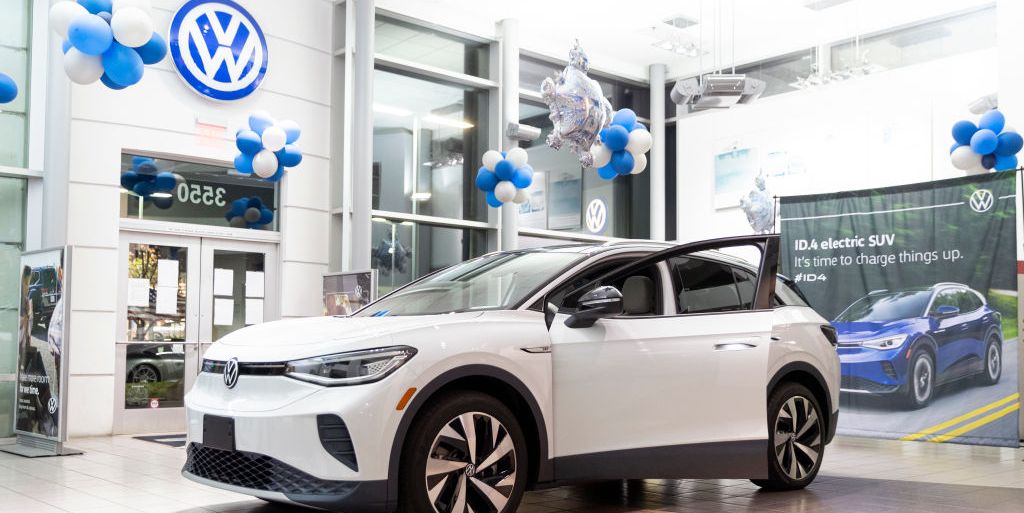Leasing an EV Is a Workaround That Could Get You That Tax Credit

As of April 18, the entire structure of federal tax credits for purchase of an electric vehicle changed conclusively. The number of EVs that qualified for a credit from $2500 to $7500 fell from dozens of models to just 18 separate vehicles (as of this week).
But there’s a large loophole: If you lease an EV, the new provisions that slashed the list of eligible vehicles don’t apply. Most Americans have never leased a car, but the prospect of $3750 or $7500 off the price of a desired EV may convince lease-resistant shoppers to run the numbers and see how much the difference amounts to.
From Dozens to Just 18
The incentive structure changed after the Inflation Reduction Act was signed by President Joe Biden last August. Sen. Joe Manchin, who provided the critical vote to get the act passed, pushed hard to limit federal tax incentives only to EVs that would support the U.S. economy, and kick-start a domestic battery minerals and cell fabrication industry. The goal was to ensure U.S. EV makers weren’t dependent on, and vulnerable to, China—by far the most prolific global source of minerals for all types of battery cells.
In practice, the IRA provisions Manchin crafted meant the EV had to be built in the U.S., Canada, or Mexico to qualify. Even tougher, its battery cells also had to use minerals sourced from a specific list of “friendly” countries that notably did not include China. Finally, those cells and battery packs had to be made in the U.S.
The result is that only a minority of EVs on the market qualify for any federal purchase credit at all. Many EVs that received federal credits last year don’t this year—though separate state, local, and corporate incentives may continue to apply.
The EPA’s Fueleconomy.gov website lists eligible vehicles (click the button for vehicles placed into service on or after April 18 to see the list). As of June 5, variants of 18 different EVs were eligible—a minority of the several dozen different battery-electric and plug-in-hybrid models for sale this year. Note eligible vehicles must carry a MSRP under $55,000 for passenger cars or $80,000 for light-duty trucks, which includes most crossovers and SUVs as well as pickup trucks.
Is a Leased Kia EV a “Commercial Vehicle”?
In December, the U.S. Treasury Department issued its guidance on interpreting the new rules specified in the Inflation Reduction Act. Under law, Congress exempted “commercial” vehicles, a definition most often applied to medium- and heavy-duty trucks, from the domestic-content rules.
But, Treasury said, since a dealer who buys a vehicle and leases it to a driver, it is a commercial transaction, since the driver or end user does not take title to the vehicle. Instead, either the dealer or a finance company holding the lease retains ownership, and receives the tax credit. The department accordingly defined leased EVs—but not purchased EVs—as “commercial” vehicles.
Because the North American battery-content and manufacturing rules specifically do not apply to commercial vehicles, any leased EV can qualify for the credit—most notably including those built overseas. Despite considerable unhappiness from Sen. Manchin, a Treasury spokeswoman told the Associated Press in a statement, “There was no room for Treasury interpretation.”
“Eligibility for the commercial vehicle credit is a straightforward reading of the Inflation Reduction Act as written by Congress and application of longstanding tax law regarding leased assets,” she said.
Dealers are still working to understand which qualifying EVs they can sell outright while assuring the buyer that car qualifies for a tax credit—and how best to explain and close leases on other EV models with buyers who historically haven’t wanted to lease, or even considered it.
Are You Curious about Leasing?
Still, automakers and dealers alike expect EV leasing to soar, possibly reaching half or more of all EV sales. Data from Edmunds shows leases reached 34 percent of total EV sales in March, up from just 18 percent in March 2023. The CEO of Ford Motor Credit told Bloomberg the carmaker’s lending arm expects six out of 10 U.S. EV drivers to lease in the short term. That’s three times the rate for vehicles with gasoline or diesel engines.
Three pieces of advice to lease-curious EV shoppers: First, note that carmakers, dealerships, and financial institutions that hold leases aren’t required to pass along the tax credit, or its full value, to the final lessee—and some don’t. Leaseholders are perfectly entitled to hold back part or all of that value, so check the numbers to ensure you’re getting the full value of that $7500 or $3750 credit.
Subaru
Many lessors will use the credit to cut the lease payment, making EVs more affordable. One example: Subaru and its Japanese-built Solterra electric SUV. A mailer from the company this week said, “New 2023 Subaru Solterra models leased through Subaru Motors Finance are eligible for a $7,500 incentive that will be used to lower the lease payment.”
Second, note that if the credit is applied to a lease, it reduces monthly payments immediately—whereas if you buy the same EV, you may have to wait a year or more to apply that credit to your taxes. However, starting next year, buyers will have the option of transferring the purchase credit to the dealer to cut the amount paid—though this provision is awaiting its own Treasury guidance.
As always, there are numerous qualifications, exclusions, and provisions within the EV tax credit that are too complex to cover here. If you take away one thing, it should be this: You can take advantage of a tax credit on pretty much any mass-priced electric vehicle if you lease.
Third and finally, the list of EVs eligible for the full purchase credit will grow steadily. Numerous carmakers have shuffled their global production mix to build new EVs, and the cells that power them, in North America. As more cars are “onshored,” as minerals mining and processing grows outside China, and as more cell plants enter production, more and more vehicles will join the list.
Meanwhile, if the specific EV you want isn’t on that EPA list, your dealer should be happy to talk to you about a lease.

Contributing Editor
John Voelcker edited Green Car Reports for nine years, publishing more than 12,000 articles on hybrids, electric cars, and other low- and zero-emission vehicles and the energy ecosystem around them. He now covers advanced auto technologies and energy policy as a reporter and analyst. His work has appeared in print, online, and radio outlets that include Wired, Popular Science, Tech Review, IEEE Spectrum, and NPR’s “All Things Considered.” He splits his time between the Catskill Mountains and New York City and still has hopes of one day becoming an international man of mystery.







